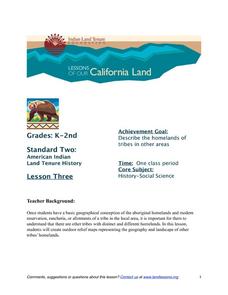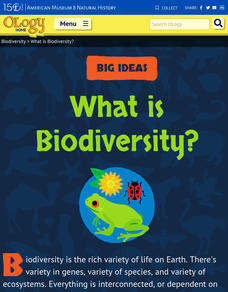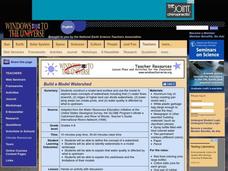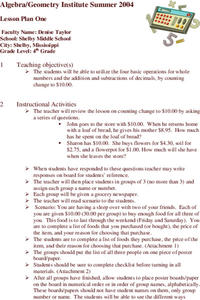Curated OER
Insects A-Z!
Alphabet insects! Who has ever heard of such a thing? Get ready because your class is going to research insects that start with a specific letter of the alphabet. In small groups, they'll use the Internet and reference texts to locate...
Polar Trec
Calorimetry Lab
Young people between the ages of 11–13 need on average about 2,000 calories per day. Within the lab, groups learn about calorimetry and respiration. They explore how it pertains to humans and animals living the Arctic where cold...
Desert Discovery
Saguaro Parts
Young biologists identify the basic structures of a saguaro cactus. They study the functions of each of the structures, and label them on a picture of a saguaro cactus embedded in the plan. This simple, and easy-to-implement lesson would...
Indian Land Tenure Foundation
More Tribal Homelands
Here is a very fun idea that introduces young learners to how geographical location affects cultural development. They are introduced to four areas where Native Americans have lived in the past by reading stories and examining images....
American Museum of Natural History
What is Biodiversity?
Not all dogs are the same just like not all finches are the same. An interactive online lesson helps individuals learn about the causes and limitations to biodiversity. The clickable sections describe the basics of the genetics of...
Missouri Department of Elementary
Ingredients of a Relationship Recipe
An eye-catching hook makes a smart analogy between ingredients for a food recipe and ingredients for quality relationships. Scholars discuss and list qualities they feel contribute to positive interactions. Pupils create a recipe card...
Curated OER
Semipermeable Membranes and Bioaccumulation
Beginning biologists place a drop of food coloring into water of differing temperatures to observe the effect on the diffusion rate. They remove the shells from raw eggs and then experiment with osmosis over the remaining membranes....
Curated OER
Build a Model Watershed
Collaborative earth science groups create a working model of a watershed. Once it has been developed, you come along and introduce a change in land use, impacting the quality of water throughout their watershed. Model making is an...
Intel
Cell-to-Cell
The third in a series of 10 STEM project-based lessons focuses on cells types, functions, and physiology. Through research, discussions, writings, and presentations, groups learn about the difference between plant and animal cells, the...
Curated OER
Food Pyramid
Second graders study nutrition and the food guide pyramid. They follow established procedures for use of programs :print in color only when directed, print only the number of copies directed by the teacher, select and use the programs...
Curated OER
Life Cycles
Using computers, Students work in small groups and progress through the roles of Explorer, Researcher, Designer, and Evaluator as they study the life cycle of plants, insects, butterflies and frogs.
Curated OER
Nutrition for Kids...and Astronauts
Second graders, in grades 2 and 5, cooperate to create a PowerPoint presentation about nutrition and food. They have a feast culminating the project and invite parents.
Curated OER
Free Enterprise--Product Cost
Students apply basic math skills in computing a product cost.
Curated OER
Food Classification
Students are introduced to classification and some of the difficulties surrounding classification and how classification systems need to be able to adapt and how they may need to be changed when new information is discovered. They...
Curated OER
Nutrition in Me!
Third graders explain the basic healthy eating and physical activity concepts. In this healthy lifestyles lesson, 3rd graders describe two main components of a healthy lifestyle, demonstrate two different types of physical activity, and...
Curated OER
Basic Operations With Decimals
Fourth graders solve real life addition and subtraction decimal problems. In groups, they read a real life scenario. They use a newspaper to gather data to solve the situation. Students create a poster containing the justification for...
Curated OER
Food For Heart Challenge
Students use a variety of locomotor motions to obtain different pictures of foods for thieir teams. They must decide if the food is always healthy.
Curated OER
Consumerism - Labeling Lab With Convenience Food
High schoolers discuss the role of the consumer in the economy and the purpose of labels on products. In groups, they follow a recipe for a calzone using only pre-made dough, sauces and toppings. To end the lesson, they create their...
Curated OER
The Biosphere
In this biosphere worksheet, students identify the different levels of organization that ecologists study. Students complete charts, sentences, and answer short answer questions.
Curated OER
Adding & Subtracting (Combining) Integers
Maintain a positive atmosphere in your math class with this fun lesson on adding and subtracting integers. After first explaining the rules for combining positive and negative numbers, this resource uses a comic strip to guide students...
Curated OER
Burn Baby Burn
Pupils use the Internet to research information on the food pyramid, recommended daily allowances of nutrients, caloric intake and expenditure, and value of foods. They analyze their own eating habits and exercise level.
Curated OER
Dinosaurs
Students are introduced to the various types of dinosaurs and write in their journals about their favorite one. After listening to a story and watching a filmstrip, they color a few pages in their Dinosaur Friends Book. They also examine...
English Linx
Commas Worksheet (Part 1)
One of the basic rules of commas is that they are similar to pauses that occur in speech. This is what this worksheet practices. The basic rules of commas will have to be reviewed before the page can be issued, but when it is in use, you...

























